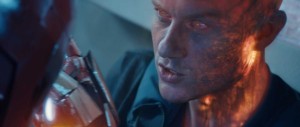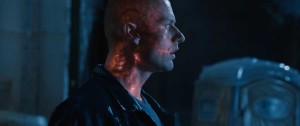 London-based visual effects house Framestore had just eight weeks to deliver 113 effects shots for Iron Man 3, working on titular character himself, and helping set the look for one of the movie’s key effects – Extremis.
London-based visual effects house Framestore had just eight weeks to deliver 113 effects shots for Iron Man 3, working on titular character himself, and helping set the look for one of the movie’s key effects – Extremis.
Directed by Shane Black, Marvel’s third installment of the Iron Man series sees Tony Stark’s world destroyed at his enemy’s hands. What follows is a story of “good, old-fashioned revenge” as Stark puts it.
Extremis is a drug that confers formidable strength, but gets red hot as it rushes around the body, visibly steaming as it flows through veins and arteries deep below the skin. Much of Framestore’s work on the film came in perfecting the Extremis look for the skull, but other shots required a digital double for one of Iron Man’s enemies and the creation of a full CG fire.
“We were given the Iron Man asset from Digital Domain and within a week had it looking great in our pipeline,” said producer Richard Graham. He explained that having just finished work on Alfonso Cuarón’s space epic Gravity, the company’s Arnold shaders for metals and hard surfaces were mature.
“We’d got well into the Extremis work before we started on Iron Man,” explained lighting supervisor Stuart Penn. “There was a lot interactive lighting between him and the Extremis effect. At one point, the enemy grabs him and heats up the suit, so we see heat glow and sparks as the suit is short-circuited. The level of interaction needed the track of the arm to be really good.”
Other facilities had already worked on the effect of Extremis on limbs, but many of Framestore’s shots focussed on the skull, which required a great deal of look development. In the end, Framestore’s skull shots set the look for the effect across the film.
 “The work by other facilities had been done on the arms where there was quite a bit of structure to play with – for example silhouetting the bones and making light wrap around them,” VFX supervisor Mark Bakowski explained. But where the arm was anatomically accommodating, the skull was less obliging.
“The work by other facilities had been done on the arms where there was quite a bit of structure to play with – for example silhouetting the bones and making light wrap around them,” VFX supervisor Mark Bakowski explained. But where the arm was anatomically accommodating, the skull was less obliging.
“Finding that formula was the most difficult part,” Bakowski added. “The skull is very densely packed and we had to thin that out a little bit to sell it.”
Stripping back from a dense, anatomical skull toward something more art directed, the team arrived at an effect that was both believable and interesting. “The main brief was to make it look as if it had volume, as if you were looking deep into the body, not like a something painted on the skin,” Penn explained.
To make sure this was achieved, the whole anatomy of the characters was modeled, from skeletons and muscles right down to blood vessels and capillaries, which resulted in some very heavy rigs. At the same time, the company had to set up a pipeline that allowed each element to be dealt with separately. It was also a big task to deform that amount of geometry and Framestore developed its own deformer to make sure everything would fit inside the skin.
“After rigging and modeling we moved onto tracking, which was a big challenge as there was body and facial tracking in every shot,” explained CG supervisor Alexis Wajsbrot. “We started with camera track, body track and facial deformation, using 3D equalizer. The trackers did amazing work in a very short space of time. The team was quite small yet they tracked over a hundred shots.”
 From there the FX team began controlling the movement of Extremis by flowing particles along the veins and arteries. “This was very choreographed and art directed, so it wasn’t easy. We needed to have full control on particle speed, flow and direction. That was a set-up done in Houdini by Selcuk Ergen (lead FX TD) and his team. By the end of the show it was just pressing buttons. It was very successful.”
From there the FX team began controlling the movement of Extremis by flowing particles along the veins and arteries. “This was very choreographed and art directed, so it wasn’t easy. We needed to have full control on particle speed, flow and direction. That was a set-up done in Houdini by Selcuk Ergen (lead FX TD) and his team. By the end of the show it was just pressing buttons. It was very successful.”
The flow of Extremis is so hot that it emits steam, something created by the Maya team, led by Horacio Mendoza using a fluid simulation. “The challenge was the deadline,” said Wajsbrot. “It was maximum of two days per shot for the steam, so we had to have a very strong set up in order to do fast simulation.”
Lighting played a huge part in revealing the depth Marvel was after. Point clouds were used to drive lighting internally beneath the skin, which was refractive, so the deeper beneath the skin the light was, the blurrier it was.
One of the main challenges Framestore had to face was reproducing the Extremis effect on four different characters and seven different sequences. The full capacity of the Framestore pipeline was used to create a small factory so that, just by just pressing a few buttons, FX TDs and lighters were able to update their shots if the model, track or even the look changed.
Framestore used its propriety solver, Flush, to create the long simulation for the fire, which needed to interact with a character walking through it. “In that shot the person is practically full CG, except for the clothes, hair, teeth and lips. We rendered everything, so it’s a full body-track,” said Wajsbrot.
Framestore completed a digital double for one of the main villains in less that two weeks, replacing their entire body in CG from the moment they’re shot to the moment they hit the ground. The scene also required some further regeneration work and a few finishing touches to make sure the character looked evil enough to deserve being shot.





